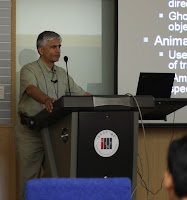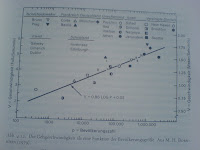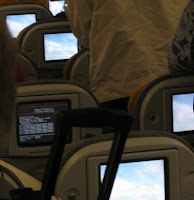Norbert Streitz – Trade-off for creating smartness

Norbert gave an interesting overview of research in the domain of ubicomp based on his personal experience – from Xerox PARC to the disappearing computer. He motivated the transition from Information Design to Experience Design. Throughout the work we see a trade-off between providing “smart support” to the user and “privacy” (or control over privacy). One of the questions if we will re-invent privacy or if it will become a commodity…
As one of the concrete examples Norbert introduced the Hello.Wall done in the context Ambient Agoras [1]. This again brought up the discussion of public vs. private with regard to the patterns that are displays. (
photos of some slides from Norbert’s talk)
[1] Prante, T., Stenzel, R., Röcker, C., Streitz, N., and Magerkurth, C. 2004. Ambient agoras: InfoRiver, SIAM, Hello.Wall. In CHI ’04 Extended Abstracts on Human Factors in Computing Systems (Vienna, Austria, April 24 – 29, 2004). CHI ’04. ACM, New York, NY, 763-764. DOI=
http://doi.acm.org/10.1145/985921.985924 (
Video Hello.Wall)

I gave a talk on “Human Interaction in Ubicomp -Magic beyond the screen” highlighting work in user interfaces beyond the screen that we did over the last years. It is motivated by the facts that classical limitations in computer science (e.g. frame rate, processing, storage) are getting less and less important to many application areas and that the human computer interaction becomes in many areas the critical part of the system.
In my talk I suggested using “user illusion” as a design tool for user interfaces beyond the desktop. This involves two steps: 1) describe precisely the user illusion the application will create and the 2) Investigate what parameters have an influence on the quality of the created user illusion for the application. (
photos of some slides from Albrecht’s talk,
Slides in PDF)

His talk focused on the domain of virtual reality with a focus on learning/training applications. One central thing I learned is that the timing of non-verbal cues (e.g. nodding) is very crucial to produce an engagement in speaking with an agent. This may also be interesting for other forms of computer created feedback.
He gave a specific example on how assigning blame works. It was really interesting to see that there are solid theories in this domain that can be concretely used to design novel interfaces. He argues that appraisal theory can explain people’s emotional states and this could improve context-awareness.
He showed an example of emotional dynamics and it is amazing how fast emotion happen. One of the ways of explaining this is to look at different dynamics: dynamics in the world, dynamics in the perceived world relationship, and dynamic through action. (
photos of some slides from Jonathan’s talk)

Motivated by the vision that after the personal computer we will see the “Personal Robot” Daijin investigates natural ways to interact with robots. For vision based interaction with robots he named a set of difficulties, in particular: people are moving, robots are moving, and the illuminations and distances are variable. The proposed approach is to generate a pose, expression, and illumination specific active appearance model.
He argues that face detection is a basic requirement for vision based human robot interaction. The examples he showed in demo movie were very robust with regard to movement, rotation, and expression and it works for very variable distances. The talk contained further examples of fast face recognition and recognition of simple head gestures. Related to our research it seems that such algorithms could be really interesting in creating context-aware outdoor advertisement. (
photos of some slides from Daijin’s talk)
Steven Feiner – AR for prototyping UIs

Steven showed some work mobile projector and mobile device interaction, were they used augmented reality for prototyping different interaction methods. He introduced Spot-light (position based interaction), orientation based interaction and widget-based interaction for an arm mounted projector. Using the synaptic touchpad and projection may also be an option for our car-ui related research. For interaction with a wrist device (e.g. a watch) he introduced the string-based interaction which is a simple but exciting idea. You pull out a string of a device and the distances as well as the direction are the resulting input parameters [2].
In a further example Steven showed a project that supports field work on identification of plants using capture (of the image of the real leaf), comparison with the data base and matching out of a subset that matches the features. Their prototype was done on a tablet and he showed ideas how to improve this with AR; it is very clear that this may also an interesting application (for the general user) on the mobile phone.
New interfaces and in particular gestures are hard to explore – if you have no idea what is supported by the system. In his example on visual hint for tangible gestures using AR Steven showed interesting options in this domain. One approach follows a “preview style” visualizations – they called it ghosting. (
photos of some slides from Stevens’s talk)
[2] Blasko, G., Narayanaswami, C., and Feiner, S. 2006. Prototyping retractable string-based interaction techniques for dual-display mobile devices. In Proceedings of the SIGCHI Conference on Human Factors in Computing Systems (Montréal, Québec, Canada, April 22 – 27, 2006). R. Grinter, T. Rodden, P. Aoki, E. Cutrell, R. Jeffries, and G. Olson, Eds. CHI ’06. ACM, New York, NY, 369-372. DOI=
http://doi.acm.org/10.1145/1124772.1124827 [3] White, S., Lister, L., and Feiner, S.Visual Hints for Tangible Gestures in Augmented Reality.Proc. ISMAR 2007 IEEE and ACM Int. Symp. on Mixed and Augmented Reality, Nara Japan, November 13-16, 2007. (
youtube video)
Finally some random things to remember:
- Richard W. DeVaul did some work on subliminal user interfaces – working towwrds the vision of zero attention UIs [4]
- Jacqueline Nadel (development psychologist) did studies on emotions between parents and infants using video conferencing
- V2 – Toward a Universal Remote Console Standard http://myurc.org/whitepaper.php
- iCat and Gaze [5]
[4] Richard W. DeVaul. The Memory Glasses: Wearable Computing for Just-in-Time Memory Support. PhD Thesis. MIT 2004. http://devaul.net/~rich/DeVaulDissertation.pdf
[5] Poel, M., Breemen, A.v., Nijholt, A., Heylen, D.K., & Meulemans, M. (2007). Gaze behavior, believability, likability and the iCat. Proceedings Sixth Workshop on Social Intelligence Design: CTIT Workshop Proceedings Series (pp. 109–124). http://www.vf.utwente.nl/~anijholt/artikelen/sid2007-1.pdf
 [see the whole set of photos from tour to North Korea]
[see the whole set of photos from tour to North Korea] The sightseeing was magnificent – see the photos of the tour for yourself. We went onto the Kaesong tour (see http://www.ikaesong.com/ – in Korea only) It is hard to tell how much of the real North Korea we really saw. And the photos only reflect a positive selection of motives (leaving out soldiers, people in town, ordinary buildings, etc. as it is explicitly forbidden to take photos of those). I was really surprise when leaving the country they check ALL the pictures you took (in my case it took a little longer as it was 350 photos).
The sightseeing was magnificent – see the photos of the tour for yourself. We went onto the Kaesong tour (see http://www.ikaesong.com/ – in Korea only) It is hard to tell how much of the real North Korea we really saw. And the photos only reflect a positive selection of motives (leaving out soldiers, people in town, ordinary buildings, etc. as it is explicitly forbidden to take photos of those). I was really surprise when leaving the country they check ALL the pictures you took (in my case it took a little longer as it was 350 photos). The towns and villages are completely different from what I have seen so far. No cars (besides police/emergency services/army/tourist busses) – but many people in the street walking or cycling. There were some buses in a yard but I have not seen public transport in operation. It seemed the convoy of 14 tourist buses is an attraction to the local people…
The towns and villages are completely different from what I have seen so far. No cars (besides police/emergency services/army/tourist busses) – but many people in the street walking or cycling. There were some buses in a yard but I have not seen public transport in operation. It seemed the convoy of 14 tourist buses is an attraction to the local people…










 Christofer Lueg
Christofer Lueg
















